How to make a container pond in a stock tank
Over the years of blogging about my stock-tank ponds (a 100-gallon container pond in my former garden, and this new 717-gallon one), I’ve been asked many times how I constructed them. I finished the new pond yesterday evening, so I’ll explain how I did it, from start to finish.
Setting up the stock tank
If you live in the Austin area, go to Callahan’s General Store to pick out your stock tank. If you live elsewhere, I suggest searching for farm- or ranch-supply stores on the outskirts of town or looking for a mail-order source. Stock tanks come in many sizes and can be either circular or oval. I recommend a 2-foot-deep tank if you plan to grow water lilies and keep fish.
Measure an area a few feet larger than the size of your stock tank, and dig out the grass or groundcover down about three inches. Using decomposed granite or paver base and a level (rest it on a long, straight board to check the level across a large distance), lay a flat, stable base, tamping it smooth and level, for your tank to sit on. It will be very heavy when filled with water, and you want to be sure it won’t sink on one side over time, making the water line in the pond look tilted too.
When the tank is positioned, fill it with clean water from a hose or, better, a rain barrel. If using tap water from the hose, let the water sit in the tank for three or four days before planting or adding fish so that the chlorine in the water has time to evaporate. Once you have fish or other wildlife in your pond, you’ll need to be careful about how you add water to compensate for evaporation. To top off small tanks like my old stock-tank pond, use rainwater or a bucket of tap water that has had time to de-chlorinate. Larger tanks like my new one may be topped off with water right out of the hose if it’s only an inch or two; the volume of water in a large tank nullifies the impact of the added chlorine, so long as it’s not too much.
Update 4/20/13: If you live in the City of Austin, chloramine is now added to our drinking water. (If you live elsewhere, check with your water provider to see if your water contains chloramine; many cities use it.) Unlike chlorine, chloramine does not dissipate on its own, and it is toxic to fish. You’ll need to buy a product to neutralize the chloramine in your pond water before adding fish. I bought a liquid product called Pond Prime from Hill Country Water Gardens in Cedar Park, and they told me that using it once a month would be sufficient. It only takes a few capfuls to treat my 8-ft. diameter (700 gallon) stock-tank pond.
Planting the stock tank
You’ll want to choose at least three types of plants for your new pond: oxygenators (submerged plants), marginals (water’s edge plants), and deep-water aquatics (plants that sit on the bottom and have leaves on the surface, like water lilies). Water lilies may be sexy, but the hard-working oxygenators are very important in maintaining a natural balance in the water, keeping algae at bay, and producing oxygen for fish. I like to use anacharis, pictured above. The nursery will sell it in small bundles wrapped in wet newspaper.
As soon as you get home, put the plants in a bucket of water or get them planted in the pond. You’ll need a few old plastic pots filled with clean pea gravel. It doesn’t matter whether the pots have holes in the bottom. Pick up a clump of your oxygenator plants…
…and carefully insert the bottom inch or so of the stems into the pea gravel of the pot. The stems are fragile, so I make a little hole in the gravel with my fingers, set the stems in the hole, and then bank the pea gravel around them.
Here’s a bunch all potted up. Anacharis doesn’t even have to be potted, I’ve heard, but doing so helps protect it from being devoured by the fish. The fish may eat it up over time. When that happens, just buy some more.
Place the potted oxygenator plant on the bottom of the tank, and that’s it. I bought six bundles of anacharis for my large stock-tank pond and filled three pots with them. I may need more, but I’ll wait and see if these grow fast enough to keep the tank clean.
Next you’ll need to build some platforms for your marginal plants. I use whatever is at hand: stacked bricks, overturned pots, and cement blocks.
Cement blocks with holes in the middle have the added advantage of giving fish a hiding place from predators like raccoons and herons.
I chose three marginal plants for my new pond: dwarf papyrus (brought over from my old pond)…
…’Black Marble’ taro…
…and a dark-leaved pond crinum from Hill Country Water Gardens.
Last but not least, the attention-getters for any pond: water lilies. Deep-water aquatics like these shade the water with their large, spreading leaves, helping to keep the pond cool, sheltering fish, and blocking out the sunlight that algae feed on. I brought over ‘Helvola‘, a dwarf yellow, from my old pond.
And I recently bought this ‘Colorado,’ a medium-to-large coral-pink lily. When purchasing water lilies for your container pond, be sure to note their mature sizes. Small stock-tank ponds like my old one have room for only one dwarf water lily. Larger ponds may be able to support two or three larger lilies.
Water lilies should be placed on the bottom of the tank if their leaves can reach the surface. If the leaves aren’t that long, place the pot on a few bricks to lift it up. As it grows, remove the bricks to lower the pot to the bottom of the pond. Once a month during the growing season (March or April to October in Austin), press a fertilizer tablet with your finger deep into the heavy soil of the water lily’s pot. Don’t let the tablet dissolve in the water, or it will contribute to algae bloom.
In Austin’s climate, hardy water lilies (as opposed to tropical ones) can be overwintered in the bottom of a 2-foot-deep stock tank. The water lily will die back to mushy stems in the winter, which should be collected and discarded from the pond. Every year in early spring, as new growth begins, divide your water lily and replant in heavy clay soil in a pond pot with no holes in the bottom. Top-dress the pot with pea gravel to keep the soil from floating into the water.
Bird-bathing and insect-drinking platform
With their sheer sides and lack of natural shelves, stock-tank ponds have the advantage of being difficult for raccoons, dogs, and cats (and small children) to get into. But it’s good to make your pond hospitable to birds, insects, and other small creatures that might want a drink or a bathe, or that fall in and need a place to crawl out. I put a stone bathing platform on top of a cement block next to the edge of the tank. It gives birds and insects easy access to the water, and I can enjoy watching them enjoying the pond.
Fish
I will add fish — native gambusia or hardy goldfish are good choices — for color and life in the pond, and for eating mosquito larvae. In fact, I never feed my goldfish, letting them forage instead on mosquito larvae, algae, bugs, and the anacharis at the bottom of the pond. Check with your supplier to find out how many fish your size pond can support. If you don’t want fish, you’ll need to rely on mosquito dunks or bits to keep larvae from hatching in the water. Questions about the water temperature and fish are answered below.
Pumps and filters
A filtered bubbler pump can be a nice addition to your pond, especially if you desire the sound of moving water. But in my experience it isn’t necessary for clear water, mosquito control, or healthy plants. It may, however, be necessary if you keep goldfish and your pond is in full sun and the surface water heats up in the summer. Goldfish prefer cool water, and a pump will help keep the water at a constant temperature by circulating cooler water from the bottom. Gambusia (native mosquito-eating fish), while not as colorful as goldfish, are hardier and will not mind warm pond water; therefore, a pump is not a necessity for them. As far as keeping the water clean and healthy, a filtered pump is not required. What matters is having an adequate amount of underwater plants, surface-shading plants, and not overcrowding your tank with fish.
Will the metal tank cook my fish or plants in summer?
This is the most common question I’m asked about stock-tank ponds from fellow hot-climate gardeners. I’ve had a small, 4-ft-diameter pond in full sun, and a large, 8-ft-diameter pond in part shade, and at no time have I ever observed the plants to suffer in the heat. After all, they’re sitting in a nice, comfy bowl of water. They’re loving summer!
Whether the water will get too warm for fish, however, depends on a number of factors: the size of your tank, how much sun it gets, whether you put a recirculating pump in the pond, and what kind of fish you choose. Goldfish prefer relatively cool water temperatures and need more oxygen as the water temperature increases. Therefore, if you stock your pond with goldfish, consider installing a pump to circulate the water and aerate it. You might also bank soil up on one side of the tank to provide insulation — easily done if your tank is situated in a garden bed rather than free-standing in the open. Alternatively, stock your pond with gambusia, native mosquito-eating fish, as they tolerate warmer water than goldfish. You can usually find both types of fish at pet stores or pond-supply stores.
Will the galvanized coating on the tank poison my fish?
I get asked this at least two or three times a month. I can only answer from my own experience: no, I’ve never noticed any problems with goldfish or gambusia (mosquitofish) dying off when placed in a galvanized tank. And I’ve seen many tanks in various gardens over the years that contain fish, including at the Wildflower Center. My mom even had one with koi for several years, although they did eventually outgrow that small tank. My advice is to wash out your tank thoroughly before filling it with water, and once you fill it hold off on adding fish for a week or two so the chlorine can evaporate and the water temperature can stabilize.
Maintenance
The only maintenance is netting fallen leaves from time to time, fertilizing once a month during the growing season, mucking out the bottom once a year, and dividing plants once a year. Expect an algae bloom — the pond will turn green — soon after you plant your pond and maybe each spring as the water heats up. But by keeping the pond stocked with oxygenator plants and being patient until the water lilies leaf out to shade the water surface, you’ll find the water clears up on its own without need for any chemicals. Just as nature does it.
This is part 1 of a 3-part pond series:
Part 1 — How to make a container pond in a stock tank
Part 2 — Winterizing a stock tank pond
Part 3 — How to spring clean your stock tank container pond
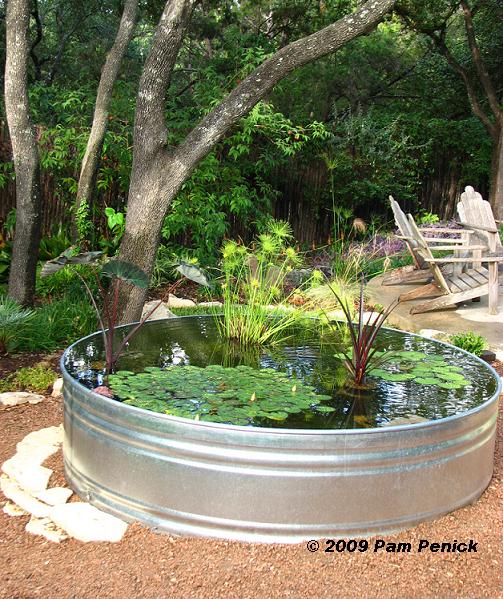
Update: August 15, 2009. Here is how the pond looks after only a few weeks!
Disclaimer: This post details what has worked for me in making a stock-tank container pond in zone 8b. Gardeners in colder zones may not be able to overwinter pond plants or fish in this way.
All material © 2006-2012 by Pam Penick for Digging. Unauthorized reproduction prohibited.


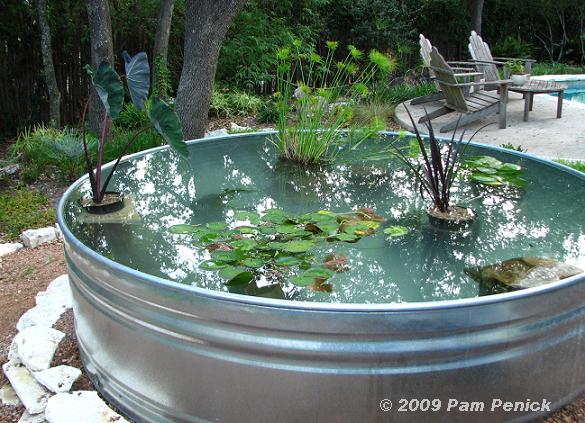
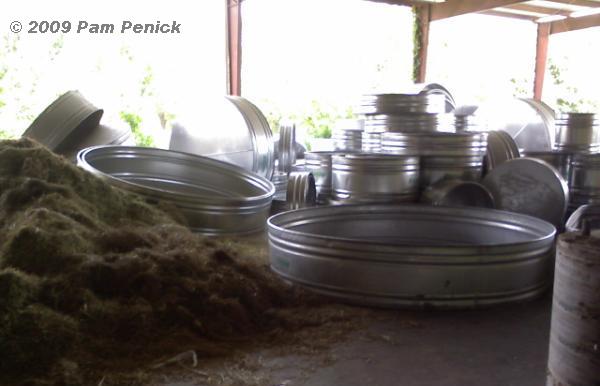
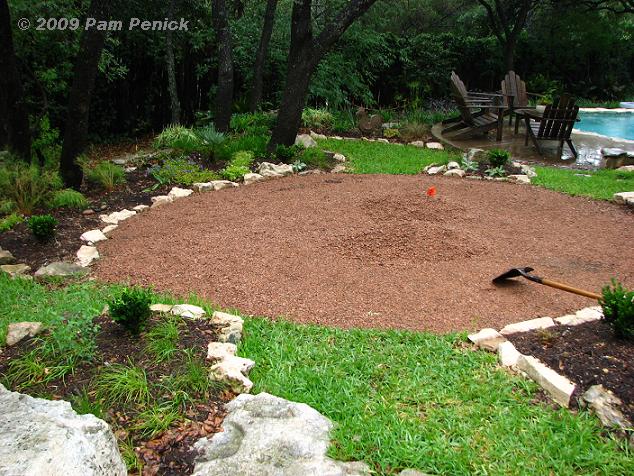
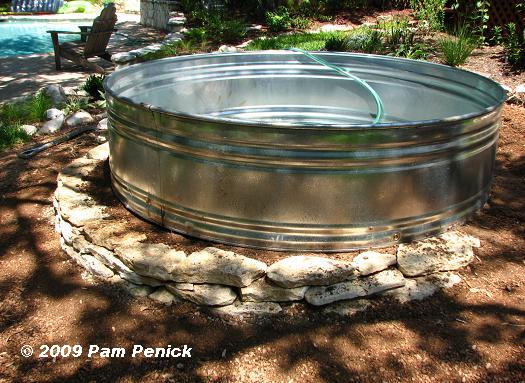
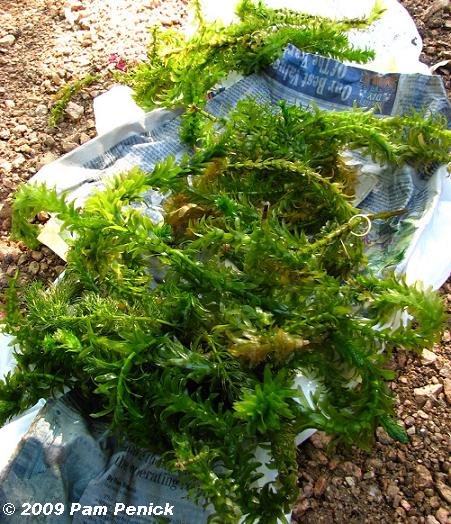
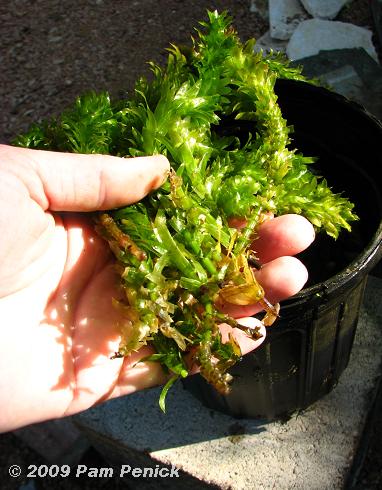
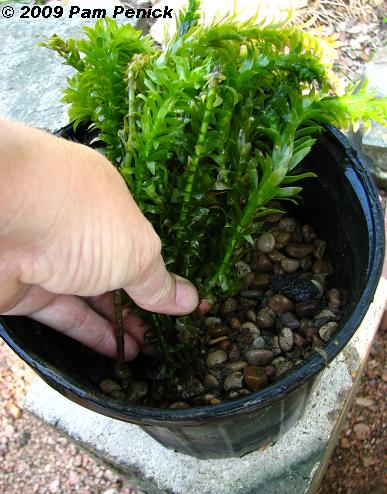
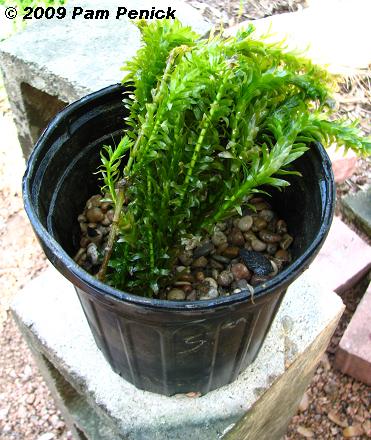
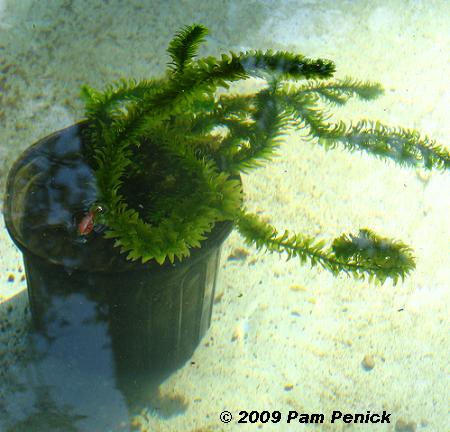
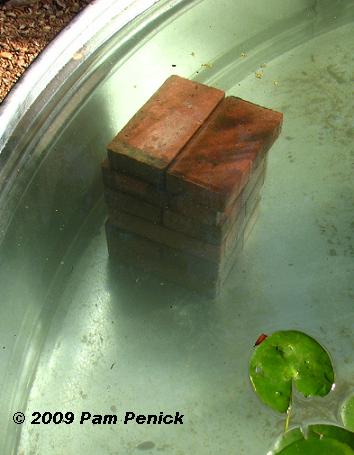
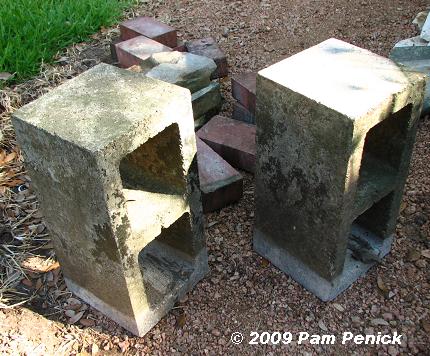
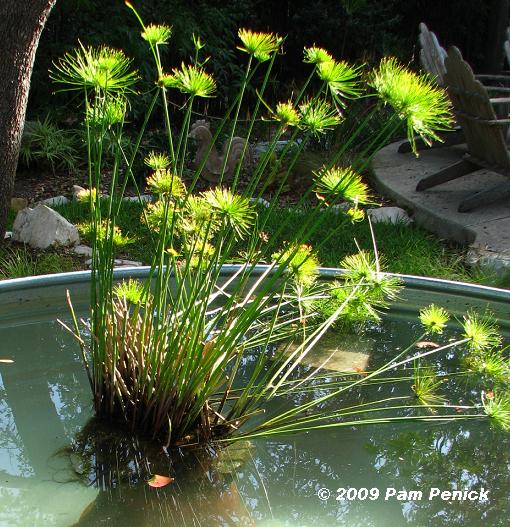
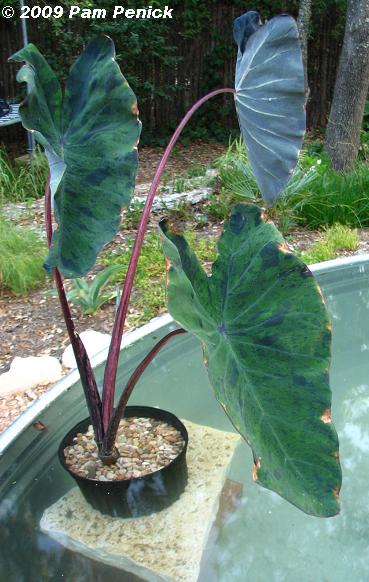
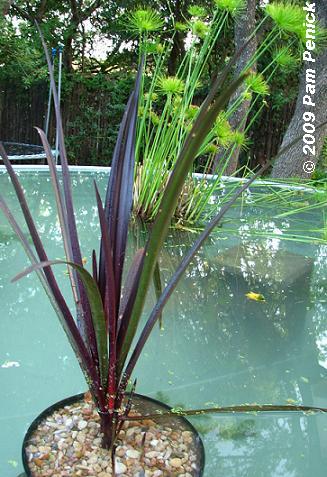
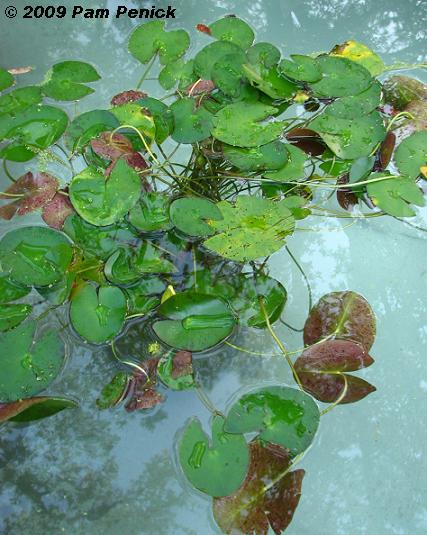
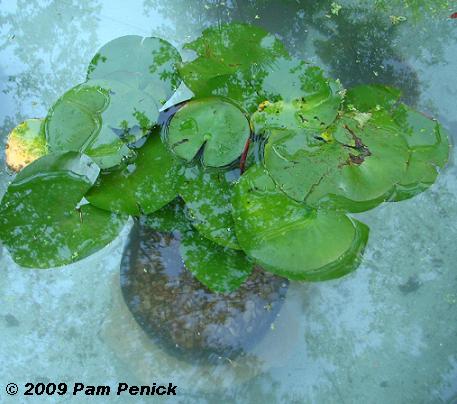
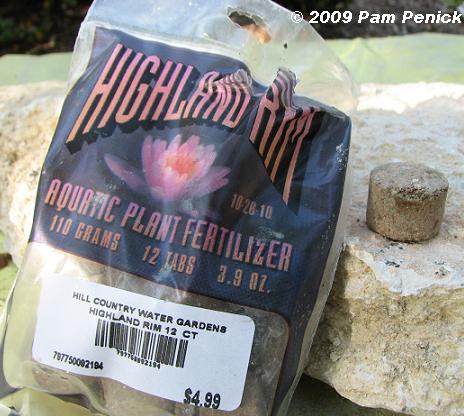
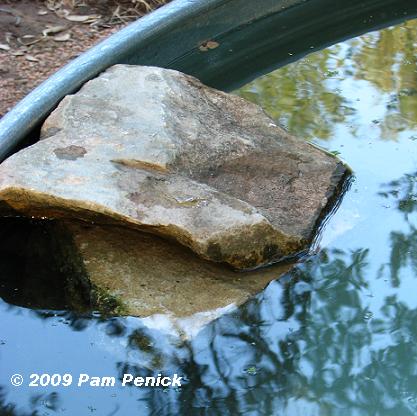
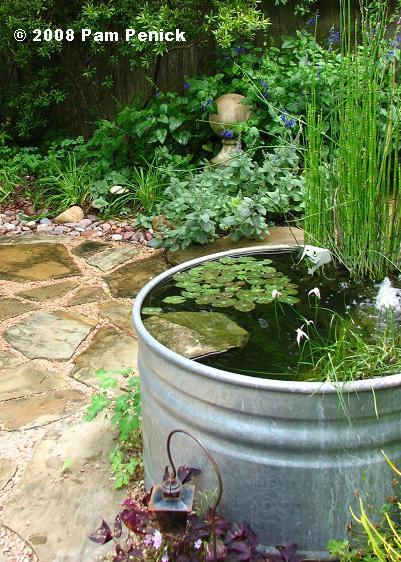
I am inspired! What a great post, and your new stock tank pond is beautiful.
Thanks for the detailed information. I have a crass question if you will. About how much does a stock tank cost?
This 8-ft diameter tank costs around $300. I believe I paid less than $100 for my small 3-ft diameter tank several years ago. —Pam
Pam it looks great! I didn’t know about the oxygenator plants. I’m going to read up on it some more.
Thanks for the tutorial Pam. Keep us posted on how the pond looks from week to week. Is it in some shade because I am wondering at the temperature of the water in our brutal summers?
Yes, it is in partial shade, Jenny. My old, smaller pond got full morning sun and afternoon shade. However, the one at the Wildflower Center is in full sun all day. They banked soil up high on one side of that tank to moderate water temperatures. —Pam
Pam, this looks great. Thanks for the photos. It makes me want to take a trip over to Callahan’s. Do you have any idea yet how often you will need to fill it? Do the plants slow down the evaporation? My vegetables in stock tanks have been doing well until the last couple of weeks with the extreme heat. They are shutting down and hoping for the best. Except for the corn which is about 4 feet tall.
Shade slows down the evaporation, so I think the plants will help reduce it as they fill in. I’ll post a weekly update on the pond and try to remember to comment about the evaporation. —Pam
This is a terrific idea! I love the look.
Congratulations on your pond — it looks great! Such a soothing, refreshing thing to gaze at in this extreme heat.
That looks really nice! Again, I would have never thought about using a stocktank for a pond.
Jake
Love it!
And thank you for writing in such careful detail about the whole process, it’s very inspiring! I’m tempted to run out and find a stock tank myself this very instant…
The other benefit to a bird-bathing platform is it provides a way for frogs to get out once they get in. For large frogs, the lily pads don’t seem to provide enough buoyancy for them to be able to jump out. This may be less of an issue with a stock tank (can they jump up into it in the first place?), but we definitely saw this in in our small in-ground pond.
Hi, Mark. I didn’t know you were blogging. Thanks for commenting. We had an occasional toad in our old pond, which was the same height as this one. I don’t know how they managed it, but I guess they are good leapers. I have heard from another local blogger that frogs get in his tank pond and spawn to excess. It’s something I’ll be looking out for. —Pam
Thank you Pam! I am so lucky to have you as my project mentor! I think I will make this our August project (shh, don’t tell the husband, I need to sneak these things up on him). I am a little worried that the place we have designated for the pond is a little too shady, although I imagine there are probably shade plants I could use too…just no water lilies, right?
Water lilies need sun, I’m afraid. But there are plenty of pond plants that will take shade, including the taro I just purchased. The biggest hassle of placing a pond in the shade of trees is the leaf litter that must be mucked out. I’ll be dealing with that myself since this pond is in partial shade under live oaks. —Pam
This is a keeper blog post for me – can’t wait to give this a try a little later down the road. Thank you for the helpful details, and enjoy!
Pam, Thank you for the instructions! Your pond looks wonderful. I did learn from the local aquatics/pond folks that tropical lilies would love the pond in the summer, but unless i insulated at least one half forget goldfish…they need cooler water. gail
Comet goldfish survived in my little stock-tank pond for several years, Gail, and it was not half-insulated. It didn’t get much afternoon sun, however, which I’m sure helped. Even if you can’t have goldfish, though, I bet gambusia, or mosquito fish, would live. Nashville can’t be as hot as Austin. Can it? —Pam
Hi Pam, your how tos are always so well thought out, taking us step by step into the process. The plantings already look terrific and the colorful fish will be icing on the cake. 🙂
Frances
Does it overflow with rain?
It can—if it ever rains in Austin again. 😉 It’s never a gush of water though. Just a light sheet of water that cascades down the sides of the tank. —Pam
Love it Pam!! I have anacharis grass in my pond. The fish nibble on it (it is not in pots), but do not destroy it. It lives all winter under the water, and multiples in spring. I always try and give some away. I have hardy goldfish that do great–as long as a certain pesky blue heron doesn’t stop by for dinner. 🙂
You did a wonderful job on the stock tank pond. I love the rustic look!
Great description and some good questions from other bloggers. So, no moving water in it? the fish will create all the ‘movement’? Really neat.
Yes, the movement will be up to the fish. I had a bubbler pump in my previous pond, but I’ve decided to let this one be still water. —Pam
Your ‘how-to’s’ are always so good – and they always make me want to do whatever it is that you have shown us how to do! I still have bookmarked a stone patio that you made (and I hope to do it sometime over the next year). One question: do you ever find snakes in your stock tank ponds?
Oh – I just left a comment at Annie’s: I saw on the evening news how terribly dry Texas is. I know that is difficult on farmers, gardeners, everyone! We’ve finally had a summer with some rain, after a dry two years – but I hate to hear that you guys are struggling. It said that some areas around the Hill Country are two feet below normal – that’s tough! Hang in there.
Eek, no, I’ve never seen a snake in there, Pam. Now I’ll be wondering if they can get into it! Thanks for the drought sympathy. It’s awful. I’m pinning my hopes on fall rains from an upcoming El Nino weather pattern. —Pam
Very nice and thorough post. I do some backyard ponds (in Michigan) and you have covered the subject very well. Just having a water feature in the yard in your heat must be refreshing. I think I’d have to wade in it now and then…or maybe even sit down. You know, like the reverse of the northern craze for outdoor hot tubs in the winter.
I’m so impressed. Your pond looks like a cool drink on our hot summer days. You should come put one in my yard in your spare time!
What spare time, Diana? I’m working hard at lounging in the pool this hot summer. Aren’t you? 😉 —Pam
I love your bathing platform. And I hadn’t thought about the advantage that stock tanks have over in-the-ground ponds when it comes to racoons. In my old pond I never put the oxygenators in pots, which may be why I was occasionally having to remove some of it; they went wild! My old pond also didn’t have any fancy pumps although I found adding a small solar water fountain in summer helped add oxygen for the fish (comets). Your tank really looks great and it’s going to be such an enjoyable addition to your backyard. Congratulations!
“It doesn’t matter whether the pots have holes in the bottom” You mean drainage isn’t a problem?–lol. It’s beautimus. That tarot is particularly beautiful! And that’s a great point about the cinder blocks providing shelter for fish.
Your new stock tank looks great, Pam – and your detailed post with its clear explanations is a gift for any Austin gardeners who want to know how it’s done.
It’s such a big step! Does seeing the water in the tank make you feel at home in the new house?
Annie at the Transplantable Rose
The new pond blows away my old one, Annie. Bigger IS better! The kids and I are already enjoying our twice-daily visits to see what’s going on in it. —Pam
You did get a colocasia/alocasia. Looks good and should be safe in the pot. They send surface runners out of the pot, I think, but are very easy to control. It should be fun to watch it all grow in.
I am not about to tackle this project, myself (lack of room) but I’m SO glad that you posted such a thorough explanation of the whole process Pam. It was very cool to follow along!
Pam, what they dubbed Pond Lily looks like the red-leafed Crinum to me. I have two of them in my bog area and have been a little disappointed in their growth habit. They may need more sun than they’re getting so I’m not giving up on them yet.
Hmm, I don’t know, Cindy. The leaves on mine are much thinner and strappier than those of the red crinums I saw pictured online. Time will tell, I guess. I hope yours settle in and start growing for you! —Pam
You did such a beautiful job of explaining this that I read every word and completely enjoyed it, and I don’t even have a pond, nor do I have plans to get one in the near future!
It just occurred to me to mention that hail will shred Colocasia in a uniquely bad way. I’ve had to cut mine to the ground after a light, sissy San Francisco hail storm; I shudder to think about what a Texas hailstorm would do. The good news is, they’re indestructible and come back in a week or two. FYI.
Fabulous post! I bookmarked it so I can revisit easily. Think I’ll print it too…
Thanks for the details–from where to get a stock tank, siting and filling, to how to plant. You answered so many questions…I’ve always wondered how to keep a still pond from being overrun by algae.
I’ll be e-mailing this link to my friends.
Pam, great details on this step-by-step. Thanks so much.~~Dee
Using the stock tank is such a great way to display aquatic life closer to eye level. This is so beautiful! Do you anticipate any problems with fish or plants being swept over the sides in a crazy Texas rainstorm?
It never happened with my old stock-tank pond, Kat. When we do get heavy rain (it’s been so long!), if the tank overflows, it just lightly sheets down the sides. Now I did have a fish jump out of the pond once… —Pam
All-right! I’ve got two small stock tanks sitting in my front yard just waiting for someone to tell me how to make them into ponds! Pam to the rescue, as always. Thanks so much. Your pond is wonderful.
Thanks, Mamaholt. Good luck with your pond! —Pam
Such a well-written, informative post! I’m printing this off for future reference, even though we’re in different zones. The method would pretty much be the same. I hope this does really well for you.
I found a stock tank at Tractor Supply. 6FT x 2FT Round. This will be the new home for some of my water lilies and goldfish. I am having two in the ground ponds (8×8) and (8X4) removed next Monday. They’ve been neglected for years and are now home to what sounds like hundreds of tree frogs at night, overgrown lilies and bunches of floating plants. All this in preparation for a new raised bed vegetable gardens.
Good luck with your reworked ponds, Jacqueline. —Pam
if it overflows with water get a drill and drill about 3 holes just avove where you want the water to stay and wen it rains the water will just go through the holes and you goldfish wont get damaged. also it is a well nice pond.
Ok, I hope I didnt miss this question already being posted… Would you recommend a pump/filter for when you add fish or do the oxygenated/ing plants take care of keeping the water healthy? Do you know if there are filters that hang on the side of the tank, like an indoor aquarium, or do you just get one that sits on the bottom? Thanks
In my experience with a 3-ft. diameter tank and an 8-ft. diameter tank, you do not need a pump or filter to keep the water clean for fish. If you live in a hot climate, you should try to give it a little shade in the late afternoon or else bank soil up on one side to help moderate the water temperature in the summer. But all you really need to keep the water in balance is plenty of oxygenating plants underwater, shading plants (like water lilies) on the surface, and the proper number of fish (too many fish is bad for water quality, not to mention the fish). Check with your fish supplier regarding the right number for your size pond. Since I’ve not used a filter, only a bubbler pump, I can’t make any suggestions about that. Good luck with your pond. —Pam
So you don’t have a water feature in the pond? I already have the tank sitting in the ground but it is empty and sad looking from a previous owner.. Guess I can just do it with out a running a water feature. Yours looks awesome. What about the fertilize for the plants you have a pic up.. Hope I can find something in Roswell, NM. Since I don’t live in Austin anymore..
Hi, David. The only water feature is the water feature, i.e., the pond itself. No pump, no fountain, no bubbler. It works great and is self-regulating once you achieve the right mix of shade plants, underwater plants, and fish (see details in my post). I’m not sure what you’re asking regarding the fertilizer; can you rephrase? Any pond nursery should carry what you need. If Roswell doesn’t have one, perhaps a road trip to Albuquerque with a couple of coolers to carry home your watery supplies in? Also, since you’re in a hot, dry climate, it might be best to site your pond with morning sun but afternoon shade to keep the water from overheating. Banking soil up on one side of the tank helps regulate temperature also. Good luck! —Pam
I enjoyed reading this very much. I live in Miami and thinking of doing a pond like this . The “soil” here is rock thus rather not dig plus plan to put it next to house in areas that gets mostly shade.
I do plan to use pond liner as not sure how safe metal would be with fish but the trough as the frame is a great idea.
Thank you
LOVE THE LOOK, AND LOOKING AT YOUR POND ANSWERED THE QUESTIONS I NEEDED….WHAT PLANTS TO PLANT WITH PEA GRAVEL..AND WATER TURNING GREEN….LET CLEAR ON ITS ON…..I WAS USING TO MANY CHEMICALS THAT WAS KILLING MY FISH….THANKS NICHO
I’m in southwest Austin, and I’m considering adding a smaller stock-tank pond to our yard this summer. I’d love to see pictures of your smaller pond, as well as pics that show how your larger pond is doing this year.
Thanks!
Robyn
Robyn, thanks for your interest. I post pictures frequently of my stock-tank pond. Click the link for my most recent pics, or click on the category “stock tanks” in my sidebar to find all my posts about it. My smaller stock-tank pond in my former garden can be found within that category, or click this link for one picture of it. —Pam
I love this pond! I would love to do something like this, but I am concerned about the bottom of the tank rusting out. I *think* this is inevitable, do you have any sense of how long it takes or if there is a way to avoid it happening?
I think rusting is inevitable too, John, and I don’t know of any way to prevent it. However, I think you get a pretty long life out of these tanks. The best way to find out, I suppose, would be to call Callahan’s General Store in Austin, which sells stock tanks and caters to ranchers, and just ask. —Pam
Hi Pam,
I am truly inspired! I do have a question. I live southwest of San Antonio TX–but it can still get fairly cold here. What recommendations do you have for overwintering fish and plants in my area–based on the size of the tank?
Cindy
Cindy, here in Austin, which gets colder than your area, my goldfish overwinter in a 2-ft deep tank with no problems. Just make sure you stop feeding them, if you feed them at all, by the time temperatures cool down. They’ll semi-hibernate at the bottom of your pond and won’t need food until the water warms back up. Hardy water lilies will just go dormant on the bottom of the tank through the winter. My marginal plants (the ones sitting on cinder blocks near the surface) have been a mixed bag. I lost my taro and pond lily last winter (I replaced them this spring), and the dwarf papyrus has been slow to recover. —Pam
Another question…Tractor Supply has the Rubbermaid stock tanks, as well as the metal ones. Are the Rubbermaid tanks OK to use?
I don’t know anything about them, Cindy. —Pam
If you’re worried about the water level and have access to a water hose or can place the tank near the water source, a simple float valve for stock tanks works perfectly. The water level will be maintained perfectly. A few years ago, I used an older stock tank that was 8 ft diameter and did the same as above but used sump pump in the bottom. I used an old metal plant stand that set below the pump. I got some lava rock and made sort of a volcano shape with chicken wire and filled it with the lava rock. The water was pumped up through the center of the lava rocks and it diffused it enough there was sort of a waterfall effect all around it. That helped to increase the oxygen in the water by a lot. Another trick to clarify the water is to use Koi clay, it’a a powder that is a fine powder loaded with minerals. You mix with some of the pond water and dump it in. It’s cloudy maybe a day or so then crystal clear. I may have to have my son bring home the ole stock tank (he was using it on some rent land for his cows) and fix it up again 😉
Thanks for the tips, Cat! —Pam
I love this. I want to get a galvanized stock tank and put a fountain in it. But, I want to spray paint it copper color. Do you know if these galvanized tanks hold paint well? Any other tips you have would be nice. Thanks
I’ve never tried painting them, Monica. If you try it, I hope you’ll report back on how it holds up. —Pam
Pam – did you ever consider digging a hole and burying a majority of the stock tank? There are some planters like this at the LBJ Wildflower center. You would, of course, want to leave around 25% of the tank above ground to keep out rain debris, etc. Just wondering if you thought of any pros/cons of burying versus keeping the water garden raised above ground. Thanks!
Hi, Brad. The main con that occurs to me is the digging! Not having to dig is the biggest advantage of making a stock-tank pond, in my opinion. —Pam
If my stock tank isn’t deep enough for fish or water lilies (11 inches of water depth), what other water plants can i use to provide the shade of a lily pad? Also, do you see any issues with elevating the tank? As mine is just a foot tall, I was hoping to raise it up (cinder blocks) for more vertical interest,then do some planting around the cinder blocks for camouflage. ‘Tanks’ as always!
Hi, Kat. You can use floating plants like duckweed to shade a shallow pond. And of course you can pack in the marginal (shallow-water) plants. As for elevating it, I don’t see any problem except issues of safety. It will be very heavy. If you live in the Austin area, check with the folks at Hill Country Water Gardens for more suggestions on plants for a shallow pond. —Pam
Just wanted to say that I am looking into installing a 20 to 30 gal pond in my yard for my every reproducing fish. I stumbled upon this page. I learned a few things and have been inspired for a few others.
Thanks for sharing your work.
Roberto
Could glass block work as platforms for marginal plants – they would be invisible in the water?
I’m sure they’d work fine, Kathy. Just FYI, even the cinderblocks become nearly invisible once the pond settles in. The inside of the tank gets coated with an algae film that makes the water look darker and more natural, just as a dark-colored swimming pool would do. The plants fill in, and you really don’t see the support blocks anymore. —Pam
Great pond! Love it.
I really love your pond! I would love to have one of my own, however I live in Missouri. I have several questions to ask…
Will I need to put my tank in the shade or shelter?
Will I need a heater for the winter or will it all be destroyed by the cold?
I have one dog that runs lose, and he loves to take dips in the pool! Any ideas on how to keep him out, but still be able to enjoy the pond?
I really love reading all of your ideas and hope that you can help!
Thanks!
Hi, Dehn. Full sun and part sun locations have worked for me in Austin. If you want to grow water lilies, the more sun the better, but if you have fish it’s nice to have a little afternoon shade. Alternatively, you can bank soil halfway up the tank along the back side to help moderate the water temperature.
I live in a warmer climate than you, so I can’t say what will work best for you in winter. I do not heat my tank, and it does freeze over once or twice a winter, but it melts quickly and the fish do just fine until then. Hardy water lilies also survive, dying back until next spring. Other plants, like dwarf papyrus, may die unless protected.
I don’t know what to advise about your swimming dog. Good luck. —Pam
WONDERFUL article! I am in San Antonio and have a stock tank pond that I love. Mine has a pump and filter in it. This is such an excellent article, thank you for taking the time to publish it. I’m sure it has helped many many people to make a pond of their own 🙂
Love your article and pictures about the stock pond. My goldfish need more space so I may give it a try. Thanks again